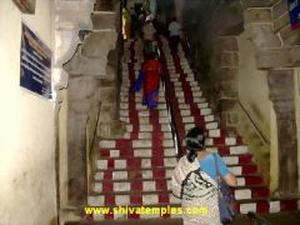Thayumanavar Temple, perched atop a hill fort at an elevation of 273 feet and accessible via 417 steps, offers a breathtaking panoramic view of Trichy city and is often referred to as the Southern Kailayam, a title that underscores its spiritual significance. The demon Tricharan ruled this area and devoted himself to the worship of Shiva, earning divine blessings. Consequently, the location is also known as Tricharapuram. The intriguing origin of its designation as the Southern Kailayam is steeped in mythological lore. According to legend, both Adisesha; the serpent king and Vayu; the god of winds traveled to worship God Shiva at Mount Kailash. As Adisesha received accolades and admiration upon his arrival, Vayu became envious, leading to a conflict between the two deities. In an attempt to assert his dominance, Adisesha coiled himself around Mount Kailash, while Vayu retaliated by unleashing a powerful wind that caused the mountain to tremble. This tumultuous encounter resulted in the mountain breaking into three fragments, which subsequently fell in distinct locations: Thirukkalathi, Trichy, and Trikonam in Sri Lanka. Thus, Thiruchiramalai earned its moniker as the Southern Kailash, reflecting its connection to this ancient narrative.
The presiding deity Thayumanaswamy is a 'swayambhu Linga'. Standing at an impressive height of 5-feet, the Shiva Linga of Thayumanaswamy is one of the largest in Tamil Nadu. The architectural design of the temple is a remarkable example of ancient craftsmanship, constructed in three distinct tiers upon the rocky terrain of the hill. The first level houses the sannidhi dedicated to the female deity Matuvar Kuzhalammai, while the second level is home to the sannidhi of Thayumanaswamy, with both sannidhis facing westward. Additionally, there are two more temples established by the King Mahendravarma Pallava during the 7th century AD which are carved and caved within the rocks, further enriching the historical significance of the location. At the summit of the hill, is the famous 'Uchchi Pillayar' Temple, adding to the spiritual and architectural allure of this sacred site.
Sthala Purana - The legend of Thayumanaswamy centers on a woman named Rathnavathi, a devout Shiva devotee, who was in labor and needed her mother to assist with the delivery. Her mother was unable to reach her due to a flood on the Cauvery river. In her desperation, Rathnavathi prayed to Shiva. He responded by appearing as her mother, helping with the safe delivery of her child, and then disappearing after the delivery. This event led to the deity's name, Thayumanaswamy, meaning "the one who acted as mother". As a result, the temple dedicated to this deity has become a significant pilgrimage site for expectant mothers and those seeking fertility. After childbirth, devotees return to express their gratitude, and the priest commemorates the occasion by tying a banana bunch and gently swinging it like a cradle before distributing the bananas as prasad to the worshippers.
The south-facing wall surrounding the sanctum features a striking representation of Dakshinamurthy, who is depicted seated on a throne crafted from 'Dharba' grass, accompanied by eight sages—a distinctive element that sets this temple apart from others. Worshippers who pay homage to Dakshinamurthy are thought to be endowed with profound knowledge and wisdom, reflecting the deity's role as a teacher and guide. In the navagraha sannidhi, the arrangement of the eight celestial bodies is meticulously designed so that they all orient towards the primary graha, the Sun, thereby creating a sanctuary that mitigates the adverse effects of these planetary influences. A particularly noteworthy event occurs during the 23rd, 24th, and 25th days of the Tamil month of Panguni, when the sun's rays perfectly illuminate the Shivalinga, creating a breathtaking spectacle. Furthermore, the temple is home to Gangala Murtha; the idol representing one of the 64 forms of Shiva.
The revered saint-poet Arunagirinathar has celebrated the divine qualities of Muruga within the temple, where Muruga is honored as Muthukumaraswamy. He is depicted with six celestial faces and twelve arms, exuding an aura of majesty as he sits upon a peacock, facing eastward. Accompanying him are his two consorts, Valli and Deivanai, who enhance the sanctity of the scene. Within another sanndhi in the temple complex, There is another Muruga represented in a standing position, characterized by a single face and four arms, once again flanked by his beloved consorts. The Thiruppugazh, a significant devotional work, contains sixteen songs that are dedicated to this deity. A multitude of deities and sages, including the esteemed sage Agathiya, Hanuman, Arjuna, Rama, Indra, the Saptarishis, Brahma, and Jatayu, have shown reverence to Thayumanaswamy.
Shiva Theertham, located within the temple grounds, is revered as a sacred water body and the legend surrounding this water body tells the story of an individual from Tiruparaithurai who, due to a transgression involving the act of blowing 'Tiru-Neeru' through his mouth, was reincarnated as a wild boar. This transformation led the boar to wander through the wilderness until it eventually found its way to a location that was once a lush forest filled with 'Vilva' trees. In a dramatic turn of events, while fleeing from hunters, the boar stumbled and fell into the purifying waters of Shiva Theertham. This immersion in the sacred waters absolved the creature of its curse, symbolizing its redemptive power. A sculpture depicting this pivotal moment, which illustrates the water's sanctity, can be observed to the right as one descends towards its edge.
The pathikam composed by Tirunavukkarasar is in 5'th Tirumurai.
 Rock Fort
Rock Fort Entrance
Entrance Path to the Temple
Path to the Temple 'Uchchi' Pillayar Sannidhi
'Uchchi' Pillayar Sannidhi Cave temple - Sculptures
Cave temple - Sculptures